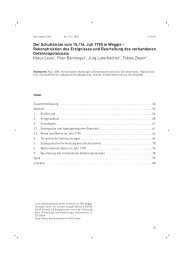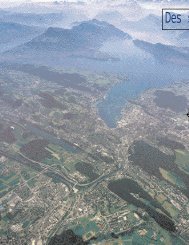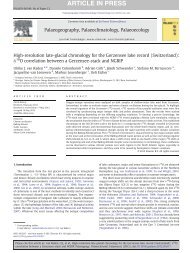Lake Sediments as Archives of Recurrence Rates and ... - Eawag
Lake Sediments as Archives of Recurrence Rates and ... - Eawag
Lake Sediments as Archives of Recurrence Rates and ... - Eawag
You also want an ePaper? Increase the reach of your titles
YUMPU automatically turns print PDFs into web optimized ePapers that Google loves.
<strong>Lake</strong> <strong>Sediments</strong> <strong>as</strong> <strong>Archives</strong> <strong>of</strong> <strong>Recurrence</strong> <strong>Rates</strong> <strong>and</strong> Intensities <strong>of</strong> P<strong>as</strong>t Flood Events 235<br />
5 Determining the Se<strong>as</strong>onality <strong>of</strong> Flood Events<br />
Flood reconstructions mainly focus on the frequency <strong>and</strong> intensity <strong>of</strong> p<strong>as</strong>t<br />
heavy-precipitation events. This allows the identification <strong>of</strong> p<strong>as</strong>t time periods<br />
<strong>of</strong> incre<strong>as</strong>ed flood activity with implications for general atmospheric circulation<br />
patterns. However, knowledge <strong>of</strong> p<strong>as</strong>t atmospheric processes leading to severe<br />
floods would substantially be improved if the individual flood layers could be<br />
se<strong>as</strong>onally resolved. With such high-resolution records, conclusions about – for<br />
example – a change in frequency <strong>of</strong> floods caused by summer thunderstorms could<br />
be drawn.<br />
Varved sediments allow a precise chronology <strong>of</strong> the lacustrine record down to<br />
the se<strong>as</strong>on b<strong>as</strong>ed on the alternating deposition <strong>of</strong> distinct laminae during the annual<br />
cycle (Zolitschka 2006). The position <strong>of</strong> detrital flood layers within the se<strong>as</strong>onal<br />
alternating laminae <strong>of</strong> a varve may be used to date the se<strong>as</strong>on they were deposited.<br />
Depending on the thickness <strong>of</strong> the varves, the position <strong>of</strong> the flood layer within a<br />
varve is visually determined either on thin sections, on high-resolution core images,<br />
or by the naked eye. To apply the concept <strong>of</strong> se<strong>as</strong>onal flood layer dating, a possible<br />
erosion <strong>of</strong> the underlying laminae needs to be considered. Thin section analysis is<br />
used to identify an erosional b<strong>as</strong>e <strong>of</strong> the detrital layer, but a safe se<strong>as</strong>onal <strong>as</strong>signment<br />
<strong>of</strong> the flood layer can be achieved by determining the se<strong>as</strong>on <strong>of</strong> the next overlying<br />
varve lamina.<br />
Unfortunately, continuously varved lacustrine sections over longer time intervals<br />
are quite rare <strong>and</strong> if present, the lake setting is <strong>of</strong>ten not sensitive to flood events.<br />
For this re<strong>as</strong>on only very few se<strong>as</strong>onal resolved flood records are documented in the<br />
literature (Lamoureux 2000; Mangili et al. 2005). With the above outlined large gain<br />
<strong>of</strong> knowledge about flood-triggering atmospheric processes, the search for lacustrine<br />
flood records in varved lacustrine sections <strong>and</strong> its detailed, but time-consuming<br />
analysis, is highly desirable.<br />
6 Occurrence <strong>of</strong> Flood Events in the P<strong>as</strong>t – C<strong>as</strong>e Studies<br />
The following two studies illustrate the application <strong>of</strong> lake sediments <strong>as</strong> archive for<br />
flood events.<br />
6.1 Flood History <strong>of</strong> <strong>Lake</strong> Lauerz, Central Switzerl<strong>and</strong><br />
<strong>Lake</strong> Lauerz is a small perialpine lake (surface area: 3 km 2 , catchment area:<br />
69 km 2 ) located in Central Switzerl<strong>and</strong> that records heavy precipitation events<br />
with typical flood layers. Piston cores were retrieved in the deepest part <strong>of</strong> the<br />
main lake b<strong>as</strong>in allowing a composite record <strong>of</strong> nearly 10 m length (Bussmann








